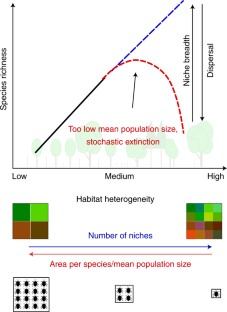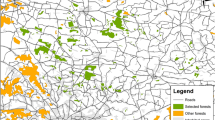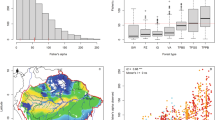Abstract
The habitat heterogeneity hypothesis predicts that biodiversity increases with increasing habitat heterogeneity due to greater niche dimensionality. However, recent studies have reported that richness can decrease with high heterogeneity due to stochastic extinctions, creating trade-offs between area and heterogeneity. This suggests that greater complexity in heterogeneity–diversity relationships (HDRs) may exist, with potential for group-specific responses to different facets of heterogeneity that may only be partitioned out by a simultaneous test of HDRs of several species groups and several facets of heterogeneity. Here, we systematically decompose habitat heterogeneity into six major facets on ~500 temperate forest plots across Germany and quantify biodiversity of 12 different species groups, including bats, birds, arthropods, fungi, lichens and plants, representing 2,600 species. Heterogeneity in horizontal and vertical forest structure underpinned most HDRs, followed by plant diversity, deadwood and topographic heterogeneity, but the relative importance varied even within the same trophic level. Among substantial HDRs, 53% increased monotonically, consistent with the classical habitat heterogeneity hypothesis but 21% were hump-shaped, 25% had a monotonically decreasing slope and 1% showed no clear pattern. Overall, we found no evidence of a single generalizable mechanism determining HDR patterns.
This is a preview of subscription content, access via your institution
Access options
Access Nature and 54 other Nature Portfolio journals
Get Nature+, our best-value online-access subscription
$29.99 / 30 days
cancel any time
Subscribe to this journal
Receive 12 digital issues and online access to articles
$119.00 per year
only $9.92 per issue
Buy this article
- Purchase on Springer Link
- Instant access to full article PDF
Prices may be subject to local taxes which are calculated during checkout



Similar content being viewed by others
Data availability
Data reported in this paper can be accessed from the Biodiversity Exploratories Information System (https://www.bexis.uni-jena.de), DataSetID 25126. All data used in this manuscript is publicly available at https://doi.org/10.25829/bexis.25126-1.
Change history
15 February 2021
A Correction to this paper has been published: https://doi.org/10.1038/s41559-020-01292-0
References
MacArthur, R. H. & MacArthur, J. W. On bird species diversity. Ecology 42, 594–598 (1961).
Stein, A., Gerstner, K. & Kreft, H. Environmental heterogeneity as a universal driver of species richness across taxa, biomes and spatial scales. Ecol. Lett. 17, 866–880 (2014).
Davies, A. B. & Asner, G. P. Advances in animal ecology from 3D-LiDAR ecosystem mapping. Trends Ecol. Evol. 29, 681–691 (2014).
Allouche, O., Kalyuzhny, M., Moreno-Rueda, G., Pizarro, M. & Kadmon, R. Area–heterogeneity tradeoff and the diversity of ecological communities. Proc. Natl Acad. Sci. USA 109, 17495–17500 (2012).
Ben‐Hur, E. & Kadmon, R. Heterogeneity–diversity relationships in sessile organisms: a unified framework. Ecol. Lett. 23, 193–207 (2020).
Chocron, R., Flather, C. H. & Kadmon, R. Bird diversity and environmental heterogeneity in North America: a test of the area–heterogeneity trade-off. Glob. Ecol. Biogeogr. 24, 1225–1235 (2015).
Kadmon, R. & Allouche, O. Integrating the effects of area, isolation, and habitat heterogeneity on species diversity: a unification of island biogeography and niche theory. Am. Nat. 170, 443–454 (2007).
Tamme, R., Hiiesalu, I., Laanisto, L., Szava‐Kovats, R. & Pärtel, M. Environmental heterogeneity, species diversity and co-existence at different spatial scales. J. Veg. Sci. 21, 796–801 (2010).
Bar-Massada, A. Complex relationships between species niches and environmental heterogeneity affect species co-occurrence patterns in modelled and real communities. Proc. R. Soc. B 282, 20150927 (2015).
Bar‐Massada, A. & Wood, E. M. The richness–heterogeneity relationship differs between heterogeneity measures within and among habitats. Ecography 37, 528–535 (2014).
Yang, Z. et al. The effect of environmental heterogeneity on species richness depends on community position along the environmental gradient. Sci. Rep. 5, 15723 (2015).
Rybicki, J., Abrego, N. & Ovaskainen, O. Habitat fragmentation and species diversity in competitive communities. Ecol. Lett. 23, 506–517 (2020).
Stein, A. & Kreft, H. Terminology and quantification of environmental heterogeneity in species-richness research. Biol. Rev. 90, 815–836 (2015).
Tews, J. et al. Animal species diversity driven by habitat heterogeneity/diversity: the importance of keystone structures. J. Biogeogr. 31, 79–92 (2004).
Seibold, S., Cadotte, M. W., MacIvor, J. S., Thorn, S. & Müller, J. The necessity of multitrophic approaches in community ecology. Trends Ecol. Evol. 33, 754–764 (2018).
Seidel, D. A holistic approach to determine tree structural complexity based on laser scanning data and fractal analysis. Ecol. Evol. 8, 128–134 (2017).
Ulyshen, M. D. Saproxylic Insects: Diversity, Ecology and Conservation (Springer International Publishing, 2018).
Allan, E. et al. Interannual variation in land-use intensity enhances grassland multidiversity. Proc. Natl Acad. Sci. USA 111, 308–313 (2014).
Zalewski, M. et al. β-diversity decreases with increasing trophic rank in plant–arthropod food chains on lake islands. Sci. Rep. 8, 1–8 (2018).
Penone, C. et al. Specialisation and diversity of multiple trophic groups are promoted by different forest features. Ecol. Lett. 22, 170–180 (2019).
Krah, F.-S. et al. Independent effects of host and environment on the diversity of wood-inhabiting fungi. J. Ecol. 106, 1428–1442 (2018).
Seibold, S. et al. Microclimate and habitat heterogeneity as the major drivers of beetle diversity in dead wood. J. Appl. Ecol. 53, 934–943 (2016).
Andringa, J. I. et al. Combining tree species and decay stages to increase invertebrate diversity in dead wood. For. Ecol. Manag. 441, 80–88 (2019).
Seibold, S. et al. Dead-wood addition promotes non-saproxylic epigeal arthropods but effects are mediated by canopy openness. Biol. Conserv. 204, 181–188 (2016).
Seibold, S. et al. Experimental studies of dead-wood biodiversity—a review identifying global gaps in knowledge. Biol. Conserv. 191, 139–149 (2015).
Malumbres‐Olarte, J., Vink, C. J., Ross, J. G., Cruickshank, R. H. & Paterson, A. M. The role of habitat complexity on spider communities in native alpine grasslands of New Zealand. Insect Conserv. Divers. 6, 124–134 (2013).
Renner, S. C. et al. Divergent response to forest structure of two mobile vertebrate groups. For. Ecol. Manag. 415–416, 129–138 (2018).
Froidevaux, J. S. P., Zellweger, F., Bollmann, K., Jones, G. & Obrist, M. K. From field surveys to LiDAR: shining a light on how bats respond to forest structure. Remote Sens. Environ. 175, 242–250 (2016).
Kadlec, T., Strobl, M., Hanzelka, J., Hejda, M. & Reif, J. Differences in the community composition of nocturnal Lepidoptera between native and invaded forests are linked to the habitat structure. Biodivers. Conserv. 27, 2661–2680 (2018).
Baz, A., Cifrián, B. & Martín-Vega, D. Patterns of diversity and abundance of carrion insect assemblages in the Natural Park ‘Hoces del Río Riaza’ (central Spain). J. Insect Sci. Online 14, 162 (2014).
Frenne, P. D. et al. Global buffering of temperatures under forest canopies. Nat. Ecol. Evol. 3, 744–749 (2019).
Müller, J. et al. Aggregative response in bats: prey abundance versus habitat. Oecologia 169, 673–684 (2012).
Jung, K., Kaiser, S., Böhm, S., Nieschulze, J. & Kalko, E. K. V. Moving in three dimensions: effects of structural complexity on occurrence and activity of insectivorous bats in managed forest stands. J. Appl. Ecol. 49, 523–531 (2012).
Leidinger, J. et al. Effects of forest management on herbivorous insects in temperate Europe. For. Ecol. Manag. 437, 232–245 (2019).
Dănescu, A., Albrecht, A. T. & Bauhus, J. Structural diversity promotes productivity of mixed, uneven-aged forests in southwestern Germany. Oecologia 182, 319–333 (2016).
Juchheim, J., Ammer, C., Schall, P. & Seidel, D. Canopy space filling rather than conventional measures of structural diversity explains productivity of beech stands. For. Ecol. Manag. 395, 19–26 (2017).
Schulze, E. D. et al. Management breaks the natural productivity–biodiversity relationship in forests and grassland: an opinion. For. Ecosyst. 5, 3 (2018).
Müller, J. et al. LiDAR-derived canopy structure supports the more-individuals hypothesis for arthropod diversity in temperate forests. Oikos 127, 814–824 (2018).
Kaufmann, S., Hauck, M. & Leuschner, C. Effects of natural forest dynamics on vascular plant, bryophyte, and lichen diversity in primeval Fagus sylvatica forests and comparison with production forests. J. Ecol. 106, 2421–2434 (2018).
Nelson, C. R. & Halpern, C. B. Short-term effects of timber harvest and forest edges on ground-layer mosses and liverworts. Can. J. Bot. 83, 610–620 (2005).
Thorn, S., Förster, B., Heibl, C., Müller, J. & Bässler, C. Influence of macroclimate and local conservation measures on taxonomic, functional, and phylogenetic diversities of saproxylic beetles and wood-inhabiting fungi. Biodivers. Conserv. 27, 3119–3135 (2018).
Fischer, M. et al. Implementing large-scale and long-term functional biodiversity research: the biodiversity exploratories. Basic Appl. Ecol. 11, 473–485 (2010).
Jung, K. & Tschapka, M. Bat Activity in all Exploratories, Summer 2008, Using Acoustic Monitoring Version 1.1.4 (Biodiversity Exploratories Database, 2018); https://www.bexis.uni-jena.de/PublicData/PublicData.aspx?DatasetId=19848
Tschapka, M., Renner, S. & Jung, K. Bird Survey Data 2008 Version 3.1.4 (Biodiversity Exploratories Database, 2018); https://www.bexis.uni-jena.de/PublicData/PublicData.aspx?DatasetId=21446
Goßner, M., Lange, M., Türke, M., Pašalić, E. & Weisser, W. Window and Ground Traps on Forest EPs in 2008 Subset Coleoptera Version1.1.3 (Biodiversity Exploratories Database, 2016); https://www.bexis.uni-jena.de/PublicData/PublicData.aspx?DatasetId=16866
Goßner, M., Lange, M., Türke, M., Pašalić, E. & Weisser, W. Window and Ground Traps on Forest EPs in 2008 Subset Hemiptera Version1.1.4 (Biodiversity Exploratories Database, 2016); https://www.bexis.uni-jena.de/PublicData/PublicData.aspx?DatasetId=16867
Goßner, M., Lange, M., Türke, M., Pašalić, E. & Weisser, W. Window and Ground Traps on Forest EPs in 2008 Subset Araneae Version 1.1.3 (Biodiversity Exploratories Database, 2016); https://www.bexis.uni-jena.de/PublicData/PublicData.aspx?DatasetId=16868
Fischer, M. Deadwood Inhabiting Fungi Presence Absence (2010, All Forest EPs) Version 1.2.2 (Biodiversity Exploratories Database, 2017); https://www.bexis.uni-jena.de/PublicData/PublicData.aspx?DatasetId=18547
Müller, J., Boch, S. & Fischer, M. Bryophyte Diversity in Forests Version 1.6.8 (Biodiversity Exploratories Database, 2016); https://www.bexis.uni-jena.de/PublicData/PublicData.aspx?DatasetId=4141
Boch, S., Prati, D. & Fischer, M. Lichen Diversity in Forests Version 1.11.14 (Biodiversity Exploratories Database, 2016); https://www.bexis.uni-jena.de/PublicData/PublicData.aspx?DatasetId=4460
Schäfer, D., Boch, S. & Fischer, M. Vegetation Records for Forest EPs, 2009–2016 Version 1.4.5 (Biodiversity Exploratories Database, 2017); https://www.bexis.uni-jena.de/PublicData/PublicData.aspx?DatasetId=20366
Doerfler, I., Gossner, M. M., Müller, J., Seibold, S. & Weisser, W. W. Deadwood enrichment combining integrative and segregative conservation elements enhances biodiversity of multiple taxa in managed forests. Biol. Conserv. 228, 70–78 (2018).
Bässler, C., Förster, B., Moning, C. & Müller, J. The BIOKLIM project: biodiversity research between climate change and wilding in a temperate montane forest—the conceptual framework. Waldökologie Landschaftsforschung und Naturschutz 7, 21–23 (2009).
Bässler, C., Müller, J. & Dziock, F. Detection of climate-sensitive zones and identification of climate change indicators: a case study from the Bavarian Forest National Park. Folia Geobot. 45, 163–182 (2010).
Bässler, C., Müller, J., Dziock, F. & Brandl, R. Effects of resource availability and climate on the diversity of wood-decaying fungi. J. Ecol. 98, 822–832 (2010).
Moning, C. et al. Lichen diversity in temperate montane forests is influenced by forest structure more than climate. For. Ecol. Manag. 258, 745–751 (2009).
Müller, J. & Brandl, R. Assessing biodiversity by remote sensing in mountainous terrain: the potential of LiDAR to predict forest beetle assemblages. J. Appl. Ecol. 46, 897–905 (2009).
Müller, J., Moning, C., Bässler, C., Heurich, M. & Brandl, R. Using airborne laser scanning to model potential abundance and assemblages of forest passerines. Basic Appl. Ecol. 10, 671–681 (2009).
Raabe, S. et al. Drivers of bryophyte diversity allow implications for forest management with a focus on climate change. For. Ecol. Manag. 260, 1956–1964 (2010).
Parker, A. J. The topographic relative moisture index: an approach to soil-moisture assessment in mountain terrain. Phys. Geogr. 3, 160–168 (1982).
Kahl, T. & Bauhus, J. Dead Wood Inventory 2012 Version 1.0.0 (Biodiversity Exploratories Database, 2018); https://www.bexis.uni-jena.de/.DatasetId=15386
McElhinny, C., Gibbons, P., Brack, C. & Bauhus, J. Forest and woodland stand structural complexity: its definition and measurement. For. Ecol. Manag. 218, 1–24 (2005).
Müller, J. & Vierling, K. in Forestry Applications of Airborne Laser Scanning: Concepts and Case Studies (eds Maltamo, M. et al.) 357–374 (Springer Netherlands, 2014); https://doi.org/10.1007/978-94-017-8663-8_18
Siitonen, J. Forest management, coarse woody debris and saproxylic organisms: Fennoscandian boreal forests as an example. Ecol. Bull. 49, 11–41 (2001).
Flynn, D. F. B., Mirotchnick, N., Jain, M., Palmer, M. I. & Naeem, S. Functional and phylogenetic diversity as predictors of biodiversity–ecosystem–function relationships. Ecology 92, 1573–1581 (2011).
Cadotte, M., Albert, C. H. & Walker, S. C. The ecology of differences: assessing community assembly with trait and evolutionary distances. Ecol. Lett. 16, 1234–1244 (2013).
Ward, L. K., Hackshaw, A. & Clarke, R. T. Do food-plant preferences of modern families of phytophagous insects and mites reflect past evolution with plants? Biol. J. Linn. Soc. 78, 51–83 (2003).
Durka, W. & Michalski, S. G. Daphne: a dated phylogeny of a large European flora for phylogenetically informed ecological analyses. Ecology 93, 2297–2297 (2012).
Kembel, S. W. et al. picante: Integrating Phylogenies and Ecology. R package version 1.7 (2018).
Vierling, K. T., Vierling, L. A., Gould, W. A., Martinuzzi, S. & Clawges, R. M. Lidar: shedding new light on habitat characterization and modeling. Front. Ecol. Environ. 6, 90–98 (2008).
Wood, S. mgcv: Mixed GAM Computation Vehicle with Automatic Smoothness Estimation. R package version 1.8.26 (2018).
Fasiolo, M. & Nedellec, R. mgcViz: Visualisations for Generalized Additive Models. R package version 0.1.1 (2018).
Steffan, S. A. et al. Unpacking brown food-webs: animal trophic identity reflects rampant microbivory. Ecol. Evol. 7, 3532–3541 (2017).
Hothorn, T., Winell, H., Hornik, K., Wiel, M. A. van de & Zeileis, A. coin: Conditional Inference Procedures in a Permutation Test Framework. R package version 1.3 (2019).
R Core Team R: A Language and Environment for Statistical Computing (R Foundation for Statistical Computing, 2018).
Acknowledgements
We dedicate this work to the memory of Kwesi Abbey Afful and Emmanuel Lartey-Williams, who were part of the moth sampling campaign. We sincerely thank the local management teams and student helpers for their assistance in the assessment of the species data, H. Hacker for moth determination, A. Ostrowski for managing the central database and M. Fischer, E. Linsenmair, D. Hessenmöller, D. Prati, I. Schöning, F. Buscot, E.-D. Schulze, W. W. Weisser and the late E. Kalko, for their role in setting up the Biodiversity Exploratories project. This work was (partly) funded by the DFG Priority Program 1374 ‘Infrastructure-Biodiversity-Exploratories’ grant nos MU3621/2-1, KR 3292/2-1 and LE3316/2-1. Field work permits were issued by the responsible state environmental offices of Baden-Württemberg, Thüringen and Brandenburg.
Author information
Authors and Affiliations
Contributions
L.H., J.M., S.B. and S.L. conceived the manuscript. J.M. designed the study. L.H., J.M., P.M., S.B., K.J., M.M.G., M.F., C.B., N.S., S.W., W.W., I.D., M.H., P.K., T.N., A.S. and P.S. acquired and processed the data. L.H., J.M., S.L., P.M., M.M.G., S.S. and W.W. drafted the manuscript. L.H., S.B., S.L., S.S., W.W., P.K., P.M., T.N., P.S., A.S., S.W., C.A., C.B., I.D., M.F., M.M.G., M.H., T.H., K.J., H.K., E.-D.S., N.S., S.T. and J.M. participated in analysing and interpreting the data and contributed critically to the revisions.
Corresponding author
Ethics declarations
Competing interests
The authors declare no competing interests.
Additional information
Publisher’s note Springer Nature remains neutral with regard to jurisdictional claims in published maps and institutional affiliations.
Extended data
Extended Data Fig. 1 Locations of the single regions from which data was derived.
The Biodiversity Exploratories project (biodiversity-exploratories.de), comprised three forest areas spanning from south to north: the Biosphere Reserve Schwäbische Alb in the Swabian Jura (ALB, 50 Plots), Hainich National Park and the surrounding area (HAI, 50 plots) and the Schorfheide-Chorin Biosphere Reserve (SCH, 50 plots). This database is supplemented with plots from the Steigerwald project in northern Bavaria (STE, 69 plots) and the BIOKLIM project in the Bavarian Forest National Park (BAY, 278 plots). In all three projects diverse environmental variables and species were monitored in a comparable fashion.
Extended Data Fig. 2 Conceptual considerations of three potential measurements used to describe horizontal heterogeneity of five (A-E) different forest stands.
The number of gaps (lilac line) is a measure which would ignore differences in gap areas (B,C). Gap area (orange line) overestimates heterogeneity when single gaps areas reach thresholds of more than 50% of the plot size (B). Here, the gap becomes the dominant habitat which makes the forest stand actually more homogeneous. Hence, the total gap area per plot would not depict a linear increase in horizontal heterogeneity because both extremes, 100% canopy cover as well as 100% gap area are homogenous in structure. Total gap edge length (red line) steadily increases with horizontal heterogeneity and incorporates both composition and configuration, thereby covering the most important information in one variable.
Extended Data Fig. 3 PCA of structural parameters.
Potential structural parameters, which could have been used to describe either vertical or horizontal heterogeneity, depicted via Principle Component Analysis. Many measures capture not the main axes and represent a mixture of both. The variables which were chosen in our analysis (BE_H_SD and Gap_total_edge length) represent the variation without inferring with each other. Colour-coding referring to the five regions: the Biosphere Reserve Schwäbische Alb (ALB), Hainich National Park and the surrounding area (HAI), the Schorfheide-Chorin Biosphere Reserve (SCH), the Steigerwald project (STE) and the BIOKLIM project in the Bavarian Forest National Park (BAY).
Extended Data Fig. 4 Correlation between selected variables.
Shown are Pearson Correlation Coefficients between the selected variables used in the GAMs, that is taxonomic (DW_TR) and type richness (DW_type) of deadwood, vertical heterogeneity measured as standard deviation of height from vegetation returns (BE_H_SD), vegetation diversity measured as Faith’s PD (in millions of years) of the plant communities (Plant_ObsPD), horizontal heterogeneity measured as the (square-rooted) total gap edge length (sqrtGap), topographic heterogeneity measured as the standard deviation of the slope of the digital terrain model (dtm_slope_sd) as well as the cover of herbs sampled within the plots (HerbCover). All variables have a R of less than 0.6, indicating no problems with multicollinearity. Colour-coding referring to the five regions: the Biosphere Reserve Schwäbische Alb (ALB), Hainich National Park and the surrounding area (HAI), the Schorfheide-Chorin Biosphere Reserve (SCH), the Steigerwald project (STE) and the BIOKLIM project in the Bavarian Forest National Park (BAY).
Extended Data Fig. 5 Correlation between height SD (left) and gap edge length (right) and the proportion of conifers in a forest stand.
Height SD decreased with increasing proportion of coniferous trees but the correlation was relatively weak (F1,495=39.64, t-value = −6.29***, R²=0.07). Horizontal heterogeneity increased with increasing proportion of coniferous trees (F1,495=131.2, t-value = 11.45***, R²=0.21). However, this is likely due to the fact that in the Bavarian Forest, many spruce stands at higher elevations have been infected by bark beetles, which lead to many gaps. Colour-coding referring to the five regions: the Biosphere Reserve Schwäbische Alb (ALB), Hainich National Park and the surrounding area (HAI), the Schorfheide-Chorin Biosphere Reserve (SCH), the Steigerwald project (STE) and the BIOKLIM project in the Bavarian Forest National Park (BAY).
Extended Data Fig. 6 Infliction points under different ranking.
Inflection points, that is, the level of heterogeneity at which species richness was highest, summarized over all six facets of heterogeneity, which were binned from 0 (lowest heterogeneity in all plots) to 1 (highest heterogeneity in all plots), ordered along dispersal ability. In contrast to Fig. 3, we further subdivided into flying and non-flying arthropods and ranked spore-disperses higher than flying vertebrates in terms of dispersal ability. However, both classification and ranking systems did not show any relationship to the infliction point (Asymptotic General Independence Test, alternative “greater”, Z=0.38, p-value=0.35).
Supplementary information
Supplementary Information
Supplementary notes, methods, Tables 1–3 and Figs. 1–7.
Rights and permissions
About this article
Cite this article
Heidrich, L., Bae, S., Levick, S. et al. Heterogeneity–diversity relationships differ between and within trophic levels in temperate forests. Nat Ecol Evol 4, 1204–1212 (2020). https://doi.org/10.1038/s41559-020-1245-z
Received:
Accepted:
Published:
Issue Date:
DOI: https://doi.org/10.1038/s41559-020-1245-z
This article is cited by
-
Meta-analysis shows that wild large herbivores shape ecosystem properties and promote spatial heterogeneity
Nature Ecology & Evolution (2024)
-
Temporal dynamics of the microbial heterogeneity–diversity relationship in microcosmic systems
Oecologia (2024)
-
Indigenous forest edges increase habitat complexity and refuge opportunities for grassland butterflies
Journal of Insect Conservation (2024)
-
Linking structure and species richness to support forest biodiversity monitoring at large scales
Annals of Forest Science (2023)
-
Landscape heterogeneity and soil biota are central to multi-taxa diversity for oil palm landscape restoration
Communications Earth & Environment (2023)



